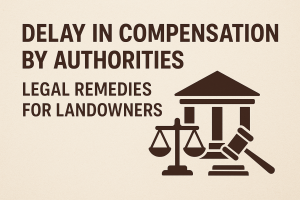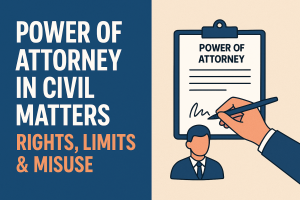Introduction
For decades, land surveys in India were carried out at the village level using manual methods like measuring ropes, outdated maps, and handwritten records. These surveys often lacked accuracy and left room for disputes over boundaries, ownership, and usage. Families found themselves stuck in conflicts that stretched on for years, with little clarity or proof to rely upon.
In recent years, technology has started to fill this gap. Satellite mapping and geo-technology are bringing a level of precision and transparency that was missing in traditional systems. From identifying exact boundaries to creating digital land records, these tools are reshaping how revenue administration works.
For a landowner, farmer, or even an investor, understanding this shift is crucial. It not only reduces the chances of disputes but also ensures that property rights are safeguarded in a way that can stand up in court. And when conflicts do arise, legal expertise combined with accurate digital data can make all the difference.
What is Satellite Mapping in Revenue Administration?
Think of satellite mapping as a bird’s-eye view that goes far beyond what traditional land surveys can capture. Instead of relying only on manual measurements or old land records, satellites use high-resolution images and GPS technology to map land boundaries, soil quality, crop coverage, and even encroachments with near-real accuracy.
For someone stuck in a boundary dispute, satellite mapping can provide:
• Defining boundaries clearly – reducing disputes between neighbours, farmers, or commercial owners.
• Detecting encroachments early – illegal occupation of land can be spotted with satellite images.
• Updating land records faster – avoiding years of delay common in manual surveys.
• Assessing agricultural usage – helping in subsidy distribution, crop insurance, and tax collection.
For an ordinary landowner or farmer, this means…
• Your land records can now be updated without repeated visits to revenue offices.
• You have stronger proof in case someone encroaches on your property.
• Any legal dispute regarding measurement or possession can be supported with scientific, court-admissible evidence.
From a legal perspective, this allows law firms to…
• Lawyers can now present satellite-based survey reports in revenue disputes or civil cases.
• It strengthens clients’ claims in litigation involving land measurement, inheritance disputes, or government acquisition.
• It helps in due diligence for real estate developers and buyers, ensuring clean titles and accurate boundaries.
Simply put, satellite mapping cuts through the age-old complexities of land surveys, making revenue administration more transparent, faster, and legally defensible.
Why It Matters to Citizens (Practical Angle)
Satellite mapping in land revenue administration is not just a “government reform”, it directly affects citizens in their everyday dealings with land.
• Clearer Ownership Records – With satellite-based surveys, land boundaries are mapped with far greater accuracy, reducing boundary disputes between neighbours and families.
• Faster Property Transactions – Verified and digitized maps mean smoother processes in buying, selling, or inheriting land, with fewer chances of fraud.
• Transparency in Compensation – In cases of land acquisition (for highways, projects, etc.), accurate satellite data ensures fair compensation by avoiding manipulation in land measurement.
• Prevention of Encroachment – Citizens can protect their property rights better as satellite monitoring helps authorities quickly detect illegal encroachments.
• Access to Credit – With clean and authenticated land records, farmers and landowners can easily use land as collateral to secure loans.
👉 The bottom line is that for an ordinary citizen, geo-tech surveys mean less litigation, less harassment at revenue offices, and more confidence in property rights.
The Legal Framework Behind Satellite Mapping in Revenue Administration
| Law / Policy | Key Provision | Relevance to Citizens |
| State Land Revenue Codes & Survey Acts | Authorises use of modern technology for surveys and settlement of land records. | Enables faster mutation, reduced fraud, and transparency. (70% of villages in Maharashtra have completed document scanning under DILRMP, improving accuracy and reducing disputes.) |
| Digital India Land Records Modernization Programme (DILRMP) | Promotes digitisation of land records and GIS integration. | Provides citizens online access to clear, updated land maps. |
| Indian Evidence Act, 1872 (Sec. 65B) | Makes certified electronic records (including satellite images) admissible in court. | Useful for landowners in property disputes. |
| Information Technology Act, 2000 | Grants legal validity to electronic records and digital authentication. | Citizens can rely on digital land records with legal backing. |
| Remote Sensing Data Policy, 2011 (ISRO guidelines) | Regulates use and dissemination of satellite imagery. | Ensures government-mapped satellite data is reliable and legally valid. |
Legal Precedent: Admissibility of Satellite Imagery
Indian courts have started recognizing satellite images as credible evidence in land and revenue disputes:
- In M/S V. S. Lad & Sons v. State of Karnataka (2009), the Karnataka High Court accepted satellite imagery from the state’s remote-sensing agency as prima facie evidence of encroachment in forest land, noting its admissibility as electronic evidence under relevant law.
• The Supreme Court has also urged the use of satellite mapping and geo-fencing to detect and monitor illegal constructions and encroachments, particularly in environmentally sensitive areas.
These cases underscore the growing trend of digital data, like satellite imagery being relied upon in Indian legal proceedings. For landowners and farmers, this means that properly documented satellite evidence can significantly strengthen claims in boundary disputes or revenue litigation.
Challenges in Implementation
Even though satellite mapping has transformed the way land surveys are conducted, several real-world challenges slow down its effectiveness:
• Digital Divide in Rural Areas
A large portion of India’s rural population still struggles with poor internet connectivity, lack of access to smartphones/computers, and limited digital literacy. Without awareness and training, citizens cannot make full use of modern land records, leaving them dependent on middlemen.
• Technical Errors & Wrong Entries
Satellite images and GIS tools, while advanced, are not free from errors. A small miscalculation in mapping or incorrect coordinates can lead to wrong land entries. Once entered into official records, these mistakes can take years of legal procedures to correct, creating new disputes instead of solving old ones.
• Resistance from Vested Interests
Traditional systems of land management allowed room for manipulation by corrupt officials, brokers, and local land mafias. Greater transparency through digital mapping directly threatens their interests. Hence, such groups may resist the adoption of satellite mapping or even try to misuse loopholes in the system.
• Privacy & Data Accuracy Concerns
Storing land-related information on digital platforms raises concerns over data protection. Citizens worry about unauthorised access, misuse of sensitive information, and wrongful tampering of land titles. This not only creates mistrust but also raises legal and ethical challenges for revenue authorities.
In short, satellite mapping is a game-changing reform, but unless these challenges are addressed through proper training, accountability, and legal safeguards, citizens may not fully enjoy its benefits.
How Law Firms Can Help You Navigate Satellite-Based Land Surveys
While satellite mapping has made land measurement more transparent, disputes and challenges still arise, especially when digital records differ from traditional ones. A law firm can guide individuals and businesses in several ways:
• Verification of Land Records – Ensuring satellite-based maps align with revenue records, sale deeds, and historical ownership documents.
• Resolving Boundary Disputes – Representing clients when discrepancies in satellite surveys cause conflicts with neighbours or government authorities.
• Assisting in Government Procedures – Helping navigate applications, objections, and hearings before revenue officers when new maps are introduced.
• Protecting Client Rights – Preventing misuse of technology against rightful landowners, especially in cases of faulty surveys or wrongful encroachments.
• Advisory on Policy Changes – Guiding farmers, businesses, and landowners on how evolving geo-tech regulations may impact their property rights.
Law firms essentially act as a bridge between advanced technology and traditional legal frameworks, ensuring that satellite mapping benefits citizens without undermining their rights. For someone facing confusion due to satellite-based surveys, having a law firm by your side means you won’t have to navigate these technical and legal complexities alone.
Transparency & Trust in Revenue Administration
One of the biggest fears that landowners face is: “Will my land records truly reflect reality?” For decades, manual surveys, unclear boundaries, and local-level disputes created opportunities for errors, manipulation, and even corruption.
With satellite mapping, the government promises greater accuracy and transparency. Each parcel of land can now be digitally verified, boundaries can be cross-checked, and records can be updated without depending only on ground-level surveys. This reduces human error and helps people trust that what is recorded in the official revenue books matches the land they actually own or cultivate.
But technology is not foolproof. Errors in digital overlays, misinterpretation of satellite images, or wrong data entries can still affect a person’s rights. A farmer might suddenly find his plot boundary shifted on the map, or a landowner might discover that his rightful share is merged into someone else’s survey number.
This is where legal intervention becomes critical. A law firm experienced in revenue administration can:
• Help you file objections when satellite data incorrectly reflects your land.
• Represent you before revenue authorities to ensure corrections are made swiftly.
• Protect your ownership rights by linking satellite records with traditional documents like sale deeds, old maps, or title records.
• Offer clarity and confidence in navigating this new mix of law + technology.
In simple words, satellite mapping builds trust in the system, but legal guidance ensures that trust is not broken in your case.
Conclusion
Satellite mapping is no longer just a tool for scientists or government agencies, it is reshaping how everyday land disputes are resolved. By bringing accuracy, transparency, and legal credibility, geo-tech is helping farmers, landowners, and even government departments reduce conflicts that often drag on for years. Courts in India have already begun accepting satellite imagery as evidence, proving its practical value in revenue administration and litigation.
For individuals facing land or boundary disputes, this shift means that reliable digital evidence can now back your claim. And with the right legal guidance, satellite data can be presented effectively before the authorities or the courts.
At Narendra Madhu Associates, we help clients navigate this modern blend of law and technology using tools like satellite imagery and mapping reports to protect property rights and resolve disputes faster.
In a world where “Gaon meets Geo-Tech,” the future of land surveys is not just about boundaries on the ground, but also about clarity from the skies.



